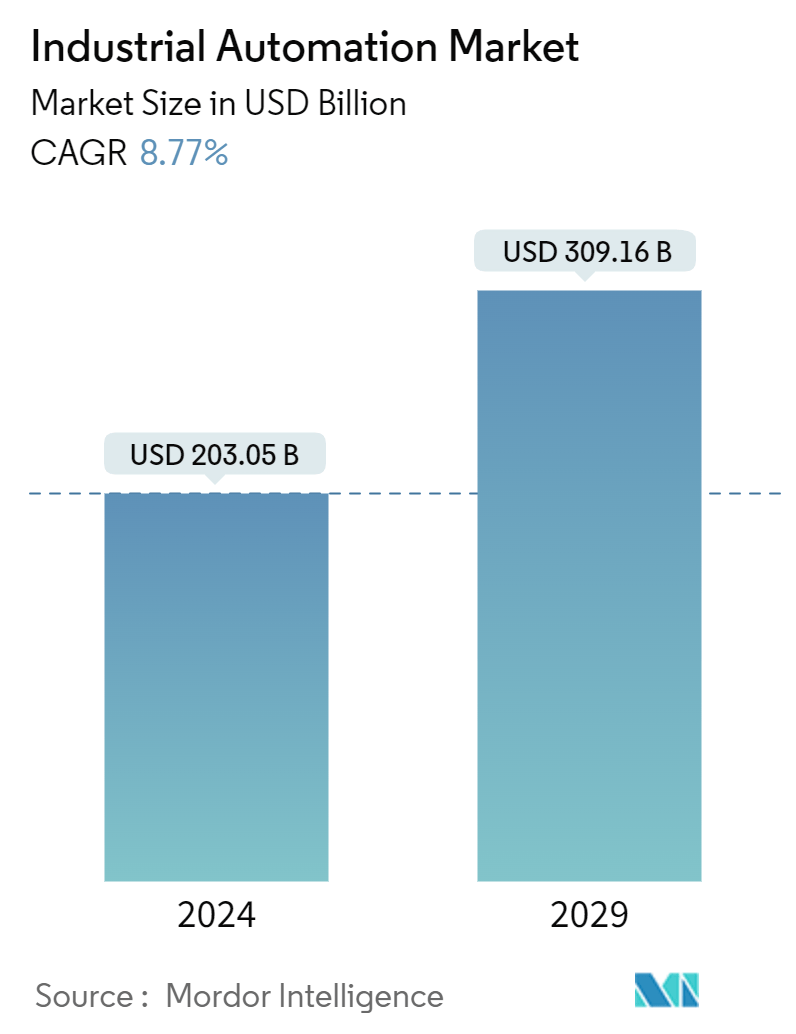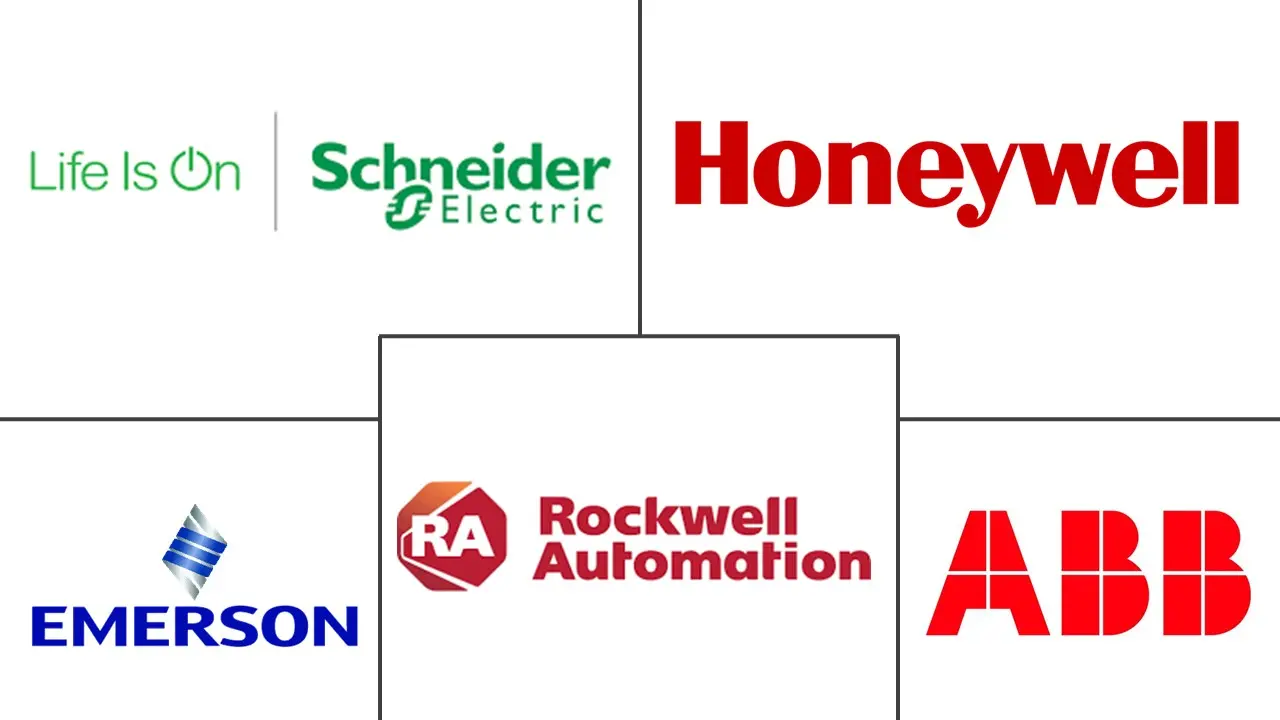Market Size of Industrial Automation Industry

| Study Period | 2019 - 2029 |
| Market Size (2024) | USD 203.05 Billion |
| Market Size (2029) | USD 309.16 Billion |
| CAGR (2024 - 2029) | 8.77 % |
| Fastest Growing Market | Asia Pacific |
| Largest Market | Asia Pacific |
Major Players
*Disclaimer: Major Players sorted in no particular order |
Industrial Automation Market Analysis
The Industrial Automation Market size is estimated at USD 203.05 billion in 2024, and is expected to reach USD 309.16 billion by 2029, growing at a CAGR of 8.77% during the forecast period (2024-2029).
- Industrial automation may potentially and considerably increase export competitiveness in developing nations. By automating their manufacturing processes, these nations can create items more quickly, effectively, and affordably, which boosts their ability to compete in the global market. This may result in higher levels of exports, better foreign currency revenues, and an improvement in the emerging economy, hence driving the market for industrial automation in developing countries.
- Industrial automation significantly impacts small and medium-sized firms (SMEs) in developing nations. Automation may boost these companies' competitiveness and achieve sustained growth. It enables SMEs to improve productivity, streamline operations, and satisfy the needs of larger customers and supply chains. For instance, Industrial automation optimizes resources and reduces production times, freeing personnel for strategic tasks. According to the International Federation of Robotics (IFR), productivity increases by up to 30% in manufacturing with automation in multiple processes.
- According to the International Monetary Fund (IMF), growth rates for emerging markets and developing economies are projected to be 4.2% in 2024 and 2025 compared to 4.3% in 2023. In many developing countries such as India, several initiatives by the Government of India, like the scrappage policy, Automotive Mission Plan 2026, and production-linked incentive scheme in the Indian market, are expected to make India a significant player in the two-wheeler and four-wheeler market. Such policies include adopting automation technologies and fostering a favorable environment for the market studied.
- Automation equipment mandates high capital investment to fund smart manufacturing (an automated system may cost millions of dollars to install, design, and fabricate). The cost of purchasing the equipment, including robotic systems, conveyor belts, sensors, and control systems, can be substantial. The factory automation equipment also necessitates the customization and integration into existing production systems. This process involves designing, engineering, and programming the equipment to meet specific manufacturing requirements. This poses a significant hindrance to the growth of the market studied.
- Apart from the direct impact evident in the supply chains and production of industrial automation solutions, the aftereffects of the pandemic are also impacting the growth of the studied market. For instance, the ongoing threat of recession looming over various regions, including North America, may negatively influence the studied market's growth as the economic uncertainty will prevent consumers and businesses from spending more on high-value products such as automobiles and expansion projects, which may impact the growth of the market studied.
Industrial Automation Industry Segmentation
The market is defined by the revenue accrued from the sales of various industrial automation solutions, including industrial control systems, field devices, and software.
The industrial automation market is segmented by solution (industrial control systems [distributed control system (DCS), supervisory control and data acquisition (SCADA), programmable logic controller (PLC), human-machine interface (HMI), and other control systems], field devices [sensors and transmitters, valves and actuators, motors and drives, robotics, and other field devices], by software [product lifecycle management (PLM), enterprise resource and planning (ERP), manufacturing execution system (MES), and other software]), by end-user industry (oil and gas, pharmaceuticals, automotive and transportation, food and beverage, power and utilities, chemical and petrochemical, and other end-user industries), by geography (North America, Europe, Asia-Pacific, Latin America, and Middle East & Africa). The report offers market forecasts and size in value (USD) for all the above segments.
| By Solution | |||||||
| |||||||
| |||||||
|
| By End-user Industry | |
| Oil and Gas | |
| Pharmaceuticals | |
| Automotive and Transportation | |
| Food and Beverage | |
| Power and Utilities | |
| Chemical and Petrochemical | |
| Other End-user Industries |
| By Geography*** | |
| North America | |
| Europe | |
| Asia | |
| Australia and New Zealand | |
| Latin America | |
| Middle East and Africa |
Industrial Automation Market Size Summary
The industrial automation market is poised for significant growth, driven by the increasing adoption of automation technologies across various sectors. This growth is particularly pronounced in developing countries, where automation is enhancing export competitiveness by enabling faster, more efficient, and cost-effective manufacturing processes. Small and medium-sized enterprises (SMEs) in these regions are also benefiting, as automation helps them improve productivity and meet the demands of larger customers and supply chains. Government initiatives in countries like India, aimed at boosting manufacturing and self-reliance, are further propelling market expansion. However, the high capital investment required for automation equipment and the ongoing economic uncertainties, such as potential recessions, pose challenges to market growth.
In the oil and gas industry, automation is increasingly being adopted to enhance safety and productivity, although growth prospects in this sector are limited compared to others. The Asia-Pacific region, home to major manufacturing economies, is experiencing robust demand for industrial automation, driven by sectors like automotive, electronics, and semiconductors. The region's initiatives to expand manufacturing capabilities and adopt electric vehicles are also contributing to market growth. The industrial automation market is highly fragmented, with key players like Schneider Electric, Rockwell Automation, Honeywell, Emerson Electric, and ABB Limited actively engaging in partnerships and acquisitions to enhance their offerings and maintain a competitive edge. These companies are leveraging advancements in AI and software-defined models to improve operational efficiency and drive innovation in automation solutions.
Industrial Automation Market Size - Table of Contents
-
1. MARKET INSIGHTS
-
1.1 Market Overview
-
1.2 Technological Trends/Advancements
-
1.3 Industry Attractiveness - Porter's Five Forces Analysis
-
1.3.1 Bargaining Power of Suppliers
-
1.3.2 Bargaining Power of Buyers
-
1.3.3 Threat of New Entrants
-
1.3.4 Threat of Substitutes
-
1.3.5 Degree of Competition
-
-
1.4 Industry Value Chain Analysis
-
1.5 Analysis of the Macro Trends on the Market
-
-
2. MARKET SEGMENTATION
-
2.1 By Solution
-
2.1.1 Industrial Control Systems
-
2.1.1.1 Distributed Control System (DCS)
-
2.1.1.2 Supervisory Control and Data Acquisition (SCADA)
-
2.1.1.3 Programmable Logic Controller (PLC)
-
2.1.1.4 Human-machine Interface (HMI)
-
2.1.1.5 Other Control Systems
-
-
2.1.2 Field Devices
-
2.1.2.1 Sensors and Transmitters
-
2.1.2.2 Valves and Actuators
-
2.1.2.3 Motors and Drives
-
2.1.2.4 Robotics
-
2.1.2.5 Other Field Devices
-
-
2.1.3 Software
-
2.1.3.1 Product Lifecycle Management (PLM)
-
2.1.3.2 Enterprise Resource and Planning (ERP)
-
2.1.3.3 Manufacturing Execution System (MES)
-
2.1.3.4 Other Software
-
-
-
2.2 By End-user Industry
-
2.2.1 Oil and Gas
-
2.2.2 Pharmaceuticals
-
2.2.3 Automotive and Transportation
-
2.2.4 Food and Beverage
-
2.2.5 Power and Utilities
-
2.2.6 Chemical and Petrochemical
-
2.2.7 Other End-user Industries
-
-
2.3 By Geography***
-
2.3.1 North America
-
2.3.2 Europe
-
2.3.3 Asia
-
2.3.4 Australia and New Zealand
-
2.3.5 Latin America
-
2.3.6 Middle East and Africa
-
-
Industrial Automation Market Size FAQs
How big is the Industrial Automation Market?
The Industrial Automation Market size is expected to reach USD 203.05 billion in 2024 and grow at a CAGR of 8.77% to reach USD 309.16 billion by 2029.
What is the current Industrial Automation Market size?
In 2024, the Industrial Automation Market size is expected to reach USD 203.05 billion.

